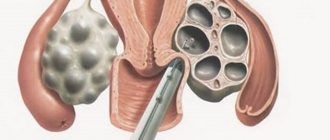Article on the topic
Prevent your child from getting sick: 5 steps to prevent asthma
Together with measles and rubella, they pose a huge danger, because we are talking not only about the health of the mother, but also about the life of the unborn baby...
“Childhood” viral diseases have a lot in common. All of them are transmitted by airborne droplets and are highly contagious. To catch any of these ailments, it is enough to inhale the tiny droplets of saliva that the patient secretes when breathing, talking, coughing and sneezing. The danger is that identifying an infected person by sight is not at all easy. It becomes contagious several days before characteristic symptoms appear. Therefore, purely theoretically, any seemingly healthy person can pose a threat to the expectant mother. Especially if it's a child. But this does not mean at all that a pregnant woman needs to panic and not go outside for the entire 9 months. It's not that scary. The main thing is to remember whether she had measles, chickenpox, mumps and rubella in childhood. If the answer is yes, the young lady can be calm: nothing threatens her and the baby. After suffering from diseases, the body has developed a strong immunity to them, so you cannot get infected again even if you want to. You only need to worry if the “childhood” sores bypassed the woman and she was not vaccinated against them.
However, even if you have been vaccinated, you should play it safe and, just in case, get tested for antibodies to pathogens. After all, 25 years after vaccination, the immunity formed to them weakens significantly, or even disappears altogether. This means that mommy has every chance of catching a dangerous infection.
Measles: strikes at a distance
Measles is one of the most contagious viral diseases. A child can catch it by being in a room where a sick person was 2 hours before. And it is enough for a pregnant woman, for example, to be in the same transport with a sick person, and they can even sit at different ends of the bus. The measles virus easily travels a distance of several tens of meters, and if it has reached a person, it will probably take over. If this trouble happens to the expectant mother, it is very important to determine the stage of pregnancy at which she fell ill. The smaller it is, the more severe the consequences. Measles infection in the first trimester in 20% of cases leads to miscarriage or various pathologies of the fetus. The baby may be born with a low level of intellectual development (oligophrenia) or serious damage to the nervous system. Moreover, these defects are the worst diagnosed at the beginning of pregnancy. Unfortunately, neither an experienced gynecologist nor a qualified ultrasound specialist will be able to say for sure whether a young lady in an interesting position will bypass trouble or whether she will fall into that ill-fated 20%. Therefore, women who have had measles in the early stages of pregnancy are often offered to artificially terminate it. But, of course, this is an extreme measure, and before deciding to take this step, a thorough examination is carried out.
The prognosis of the disease suffered after the 16th week of pregnancy is more encouraging. At this stage, measles, as a rule, proceeds more easily and does not have a negative effect on the fetus. The disease is prevented from spreading by the placenta, which by this time has finally formed and reliably protects the unborn baby from the negative effects of harmful factors. However, in the last weeks of pregnancy the danger reappears. If the mother gets sick closer to the end, then she can infect her little one when he passes through the birth canal. Back in the middle of the last century, such a “gift” could have led to the death of a child, but now that doctors have strong antibiotics and modern resuscitation methods in their arsenal, infant mortality from congenital measles infection has decreased significantly. The chance that something irreparable will happen to the baby is negligible.
Chickenpox: rare, but accurate
Doctors say that most people who think they never had chickenpox as children actually had it in such a mild form that they didn’t even notice it. Only 4% of adults are immune to this disease. Apparently, this is why it rarely occurs in pregnant women. According to statistics, out of 2,000 expectant mothers, only one catches the chickenpox virus. If a woman falls ill before 20 weeks, miscarriage and intrauterine fetal death are possible. If the pregnancy continues, the danger still remains. The baby may develop the so-called congenital chickenpox syndrome. The defects it causes include scars on the skin, underdevelopment of muscles and bones of the extremities, cataracts, various neurological disorders (atrophy of the cerebral cortex, mental retardation, urinary and fecal incontinence, etc.). Fortunately, this syndrome is no more common than the disease itself. The probability that it will form in a baby does not exceed 2%. But it’s still better to play it safe and undergo an unscheduled ultrasound, which will determine whether the chickenpox virus has reached the fetus, and if so, what is the extent of its damage.
No less dangerous is a disease contracted in late pregnancy, especially 4-5 days before birth. When a baby is born, it can become infected from its mother. The tragedy is that chickenpox in infants is very difficult and is often accompanied by complications: bronchopneumonia and damage to internal organs. Unfortunately, not all kids cope with this test. A third of them die. Therefore, if the expectant mother gets chickenpox a few days before the expected delivery, doctors often try to artificially delay it. And if this is not possible, then immediately after birth the baby is given immunoglobulin and antiviral treatment is carried out. Such measures do not protect the newborn from infection, but can significantly reduce the risk of death.
Treatment of chickenpox during pregnancy
It should be noted that there is no specific therapy, that is, therapy directed against a specific pathogen, for childhood infections, so individual symptoms are treated.
This set of therapeutic measures includes bed rest, drinking plenty of fluids (mineral water, fruit drinks), for headaches and elevated body temperature, painkillers and antipyretics (for example, paracetamol), vitamin therapy are prescribed, and for a dry, obsessive cough, expectorants are prescribed.
In case of measles, hygienic care of the skin and mucous membrane of the eyes is required (a 20% solution of sodium sulfacyl is instilled into the conjunctival sac).
Treatment of skin manifestations of chickenpox consists of reducing itching and preventing the addition of a bacterial infection. The elements of the rash are lubricated with antiseptic solutions (an aqueous solution of brilliant green or potassium permanganate), it is necessary to monitor oral hygiene (rinse your mouth with solutions of chlorhexidine, calendula, chamomile after each meal). To reduce itching, antihistamines (for example, suprastin) are prescribed internally. In case of a complicated course of this disease with associated bacterial pneumonia, antibiotics are prescribed.
Pig: scary only at first
Mumps, or mumps as doctors call it, is less contagious than chickenpox or measles. Even close contact with a carrier does not always lead to the development of the disease. Nevertheless, this disease is common among expectant mothers. Mumps is most dangerous in the first trimester, when the virus can easily reach the embryo. In this case, the pregnancy often stalls or spontaneous abortion occurs. As a rule, this happens 2 weeks after the woman falls ill. There is also an assumption that the mumps virus affects the ovaries and it is for this reason that a miscarriage occurs. If the pregnancy continues and the unborn baby continues to develop, then there is no reason to worry. The expectant mother can safely drive away thoughts about possible anomalies. Mumps does not cause developmental defects, so the baby will be born healthy.
If a pregnant woman catches an infection shortly before giving birth, she can infect her child, as is the case with chickenpox and measles, when he is born. Or a little later, putting the baby to the breast, since the mumps virus is easily transmitted through mother's milk. But even in this case, the prognosis is favorable. Typically, mumps, even in young children, is relatively mild and does not cause complications.
How does the disease manifest?
As a rule, the first symptoms of coronavirus develop 5-7 days after infection. There are three clinical forms of the disease:
- Easy. Accompanied only by symptoms of ARVI.
- Average. In this case, the patient develops pneumonia, but it is easily treatable and does not threaten human life.
- Heavy. Accompanied by pneumonia and acute respiratory failure
In addition, in some patients, coronavirus infection may be asymptomatic.
The most common signs of infection include:
- high body temperature, fever;
- dry debilitating cough;
- a sore throat;
- feeling of lack of air, shortness of breath;
- general weakness, exercise intolerance.
Other signs may occur less frequently: symptoms of body intoxication (diarrhea, nausea, vomiting), headaches, hemoptysis, heart rhythm disturbances, confusion, nasal congestion, muscle pain. In some cases, there is a loss of smell, the appearance of a rash on the body, and a change in the color of the skin on the arms and legs.
Signs of respiratory failure
Respiratory failure leads to oxygen starvation of the body, which affects the functioning of the brain and heart. Main signs of respiratory failure:
- Rapid breathing. Shortness of breath is a harbinger of respiratory failure. The lower the level of oxygen in the blood, the faster the body tries to eliminate its shortage.
- Cardiopalmus. The faster the heart beats, the faster the blood is saturated with oxygen.
- Loss of consciousness. This condition occurs when the brain begins to experience oxygen starvation.
- Low blood pressure. The drop in pressure is caused by blood retention in the vessels of the lungs due to passive gas exchange.
- Asymmetrical respiratory movements of the chest. For example, one lung may work less than the other. Also, the respiratory function can be carried out by only one lung.
Rubella: danger code – red!
Rubella is the most dangerous “childhood” infection for pregnant women, because the disease in the early stages always (!) leads to the loss of the child. If the infection occurs in the first trimester, the infection will certainly reach the fetus. As a result, a miscarriage may occur. In the case when pregnancy continues after an illness, irreversible changes occur in the development of the child. Most likely, the baby will be born with congenital rubella syndrome, the so-called pathological triad: cataracts, heart disease and deafness. In addition to this, microcephaly (reduction in the size of the brain), microphthalmia (reduction in the size of the eyeballs), enlarged fontanelles, inflammatory diseases of the brain, damage to the vestibular apparatus, and malformations of the skeleton and genitourinary organs may be added. And this is not a complete list of the “dowry” of a baby who was infected in utero. That is why pregnant women who have had the disease in the first trimester are recommended to have an abortion for medical reasons. Otherwise, the baby will be born defective.
If infection with the rubella virus occurs after 16 weeks, then the risk of giving birth to a toddler with developmental defects remains, but becomes minimal. It is believed that in the 4th month of pregnancy the risk of infection of the fetus is 5-6%, in the 5th and later – about 1-1.7%. Therefore, there is no need to terminate the pregnancy. But you should prepare for the fact that the baby may be born with short stature and low body weight. In the future, such children lag behind their peers in physical development. If the mother becomes infected on the eve of childbirth, the baby will develop typical skin rashes, which will soon go away. And the baby himself will remain contagious for several months after birth.
Rubella during pregnancy
One of the most unfavorable infectious diseases during pregnancy is rubella.
Its pathogen is transmitted from a sick person by airborne droplets. Infection occurs through close contact with a sick person (staying together in a room, caring for a sick child). Despite the fact that the infectious agent of rubella is less than that of measles and chickenpox, infection creates a very serious threat to the fetus and the risk of giving birth to a child with developmental defects.
Rubella infection is especially dangerous in the first trimester (before the 14th week of pregnancy). It is believed that the risk of fetal damage in the third trimester (after the 28th week of pregnancy) is significantly reduced.
When the virus penetrates the placenta, congenital fetal rubella develops. As a result, the normal development of fetal tissue and organ formation are disrupted, which leads to the death of the embryo in early pregnancy, spontaneous miscarriage, premature birth, stillbirth, or the birth of a child with congenital malformations.
Characteristic fetal malformations caused by the rubella virus are:
- cataract (clouding of the lens);
- congenital heart defects;
- deafness;
- diseases of the central nervous system (mental retardation, cerebral palsy, etc.).
The period from contact with a person with rubella to the appearance of the first signs of the disease (incubation period) can last up to 21 days.
Rubella begins with enlargement of the lymph nodes of the occipital region and an increase in body temperature to 38ºC, a runny nose and cough may appear, after 2-3 days a characteristic rash appears - first on the face, then on the torso and limbs, pinpoint, pink, non-confluent, slight itching may be observed . The period of rash lasts from several hours to 2 days. The rash goes away on its own and without leaving a trace. The diagnosis of rubella is made based on the pregnant woman's medical history (contact with a sick person) and the characteristic rash.
It is important to note that rubella in half of pregnant women can be asymptomatic, so if the expectant mother came into contact with a person who recently had rubella, or with a person who fell ill 2-3 days after the meeting (the woman was not vaccinated against rubella and I had it as a child), you need to urgently consult a doctor.
In such a situation, laboratory diagnostics becomes important. Infection with rubella is indicated by the appearance in the blood serum of a pregnant woman of class M immunoglobulins (IgM - protective specific antibodies that are formed in response to rubella infection and appear at the end of the period of rash or after the rash disappears). To confirm or refute the fact of rubella infection, a similar study is carried out twice with an interval of 14 days. In this case, consultation with an infectious disease specialist is mandatory.
A pregnant woman may get sick with a disease uncharacteristic for her age if she is not vaccinated on time.
A pregnant woman contracting rubella in the first trimester (before 14 weeks of pregnancy) and indicating contact with someone with rubella during this period is a medical indication for termination of pregnancy.
If rubella disease occurs at a later date (over 14 weeks), then the issue of continuing pregnancy is decided individually by a group of doctors, taking into account clinical data (signs of threatened miscarriage), ultrasound data (fetal malformations in combination with signs of placental insufficiency or infection of the placenta, high or low water levels) and laboratory research methods (detection of a virus or specific antibodies in blood serum).
If malformations of the fetus, signs of infection of the placenta, or severe intrauterine growth retardation are detected, the question of terminating the pregnancy with the consent of the patient at any time is raised.
Vaccinations against childhood infections
To prevent the risk of rubella infection and dangerous complications during pregnancy, all women of reproductive age need to be vaccinated against the rubella virus.
The minimum period from vaccination to planned pregnancy is 3 months and is dictated by the need for time for the production of protective antibodies in the woman’s body. Since the likelihood of the fetus being affected by the virus that the vaccine contains is purely theoretical, the fact of accidental use of the vaccine during pregnancy is not an indication for its termination. If such a pregnancy continues or if rubella is contracted for a period of more than 28 weeks, the expectant mother is at high risk for the development of complications during childbirth and the postpartum period (discoordinated labor, bleeding, purulent-inflammatory complications may occur) and complications from the fetus (asphyxia newborn).
A child born to a mother who had rubella during pregnancy is a carrier of the virus. This baby is in an isolated ward in the observation department. A child born with suspected congenital rubella undergoes a thorough examination in the maternity hospital and is subsequently observed by appropriate specialists.
Vaccination is not required if you have had rubella (documented). In doubtful cases (for example, when a woman does not know whether she has had rubella), a blood test is performed to identify specific antibodies. The absence of antibodies to the rubella virus confirms the need for vaccination.
If pregnancy has occurred and no specific antibodies against rubella are detected in the blood, i.e. there is no immunity, it is necessary to avoid crowded places and socializing in groups of children, since rubella vaccination is not carried out during pregnancy.
Expert opinion
Anna Mtskhvetaridze, obstetrician-gynecologist at the American Medical Center:
– Several years ago in Russia, most people suffered from “childhood” infections at an early age, so these diseases in pregnant women were not such a pressing problem. Currently, many children do not go to kindergartens, as a result of which their risk of disease increases in the future. If you did not have rubella, measles, chickenpox and mumps when you were a child, be sure to get vaccinated several months before conception. During pregnancy, immunization cannot be carried out, since the live virus on the basis of which vaccines are created can adversely affect the fetus. If pregnancy has already occurred, and tests show that you do not have immunity to pathogens of “childhood” diseases, treat your health with the utmost care and try to avoid contact with children.
Recognize the enemy by sight
Measles – fever and cough . The first symptoms of measles can easily be confused with a common cold. You feel lethargic and weak, your temperature rises, your eyes are watery, your throat hurts, you have a runny nose and a dry “barking” cough. After 2-3 days, small whitish spots, similar to semolina, appear on the inside of the cheeks. And after a few days, the ears, face, body and limbs become covered with small red spots, which gradually darken and merge into large figures, between which healthy skin is visible.
Chickenpox - blisters on the lips. Chickenpox also begins with a high fever and general malaise. After a few days, a blistering rash appears on the lips and scalp, which gradually spreads to the torso. These are raised, fluid-filled pustules that later dry out and turn into crusts. Do not scratch the blisters under any circumstances, otherwise scars may remain on the skin.
Mumps - pain behind the ears . The first sign of mumps is an enlarged salivary gland. Usually they become inflamed on both the left and right, but only one of them can be affected. If you press your finger behind your ear, you will feel severe pain. It becomes difficult for you to talk, chew and swallow food. The temperature may remain normal.
Rubella is blotchy skin . With rubella, the lymph nodes in the back of the head become very swollen. Then a rash appears behind the ears and on the face, which quickly spreads throughout the body. The lesions are small, do not connect with each other and disappear within 2-3 days.











